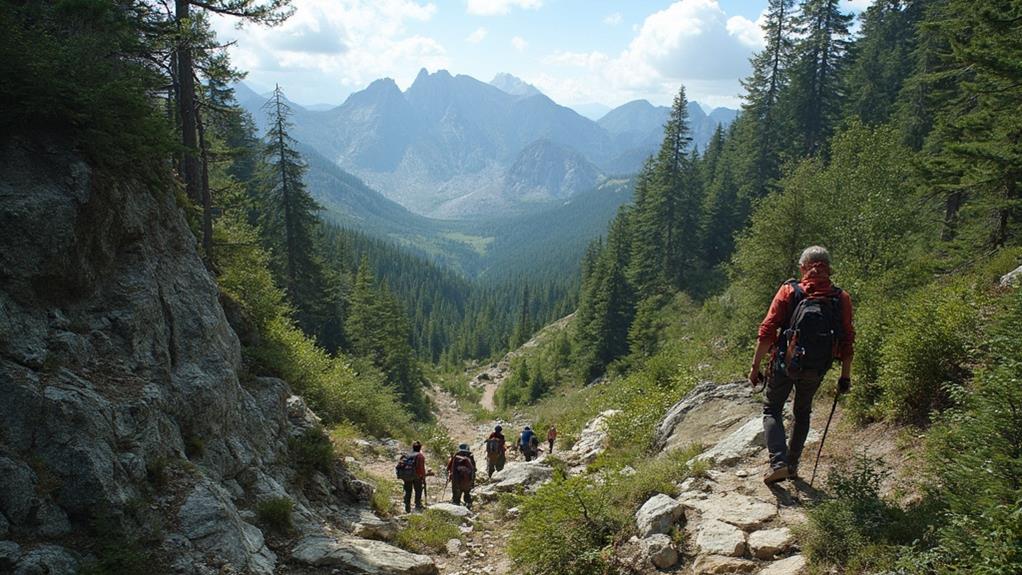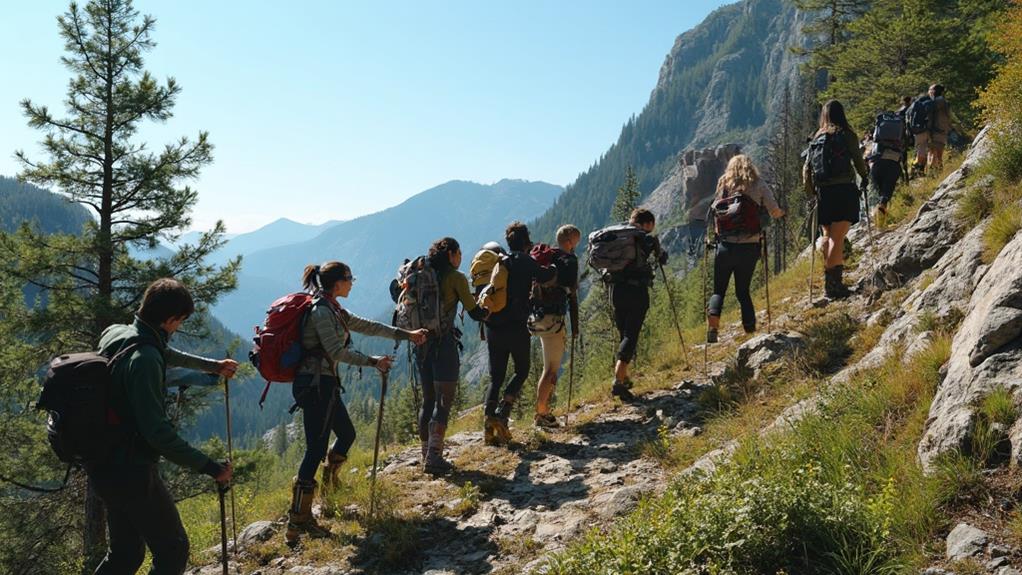Training for hikes with steep climbs necessitates a strategic mix of aerobic capacity building, strength training, and interval workouts. Enhancing oxygen efficiency through endurance exercises like cycling and swimming is essential. Strength training, focusing on high repetitions and low weight, enhances muscular endurance, critical for stability on rugged terrains. Incorporating HIIT fosters cardiovascular fitness, while progressive overload techniques using weighted backpacks mimic real hiking conditions. Core exercises bolster balance and resistance against steep slopes. Adequate hydration and energy-dense nutrition maintain performance efficiency. These elements combined prepare the body for rigorous ascents, laying the foundation for further insights into effective hiking preparation.
Key Takeaways
- Incorporate aerobic exercises like hiking and cycling 2-3 times weekly to enhance oxygen efficiency and endurance for steep climbs.
- Perform strength training, focusing on high repetition, low weight exercises, 2-3 times weekly to improve stability and balance.
- Use diaphragmatic breathing techniques to maximize oxygen efficiency, reducing fatigue during elevation gains.
- Gradually increase pack weight by no more than 10% weekly to build strength and cardiovascular endurance.
- Train on varied terrains, including hills and stairs, to optimize muscle adaptability for steep climbs.
Aerobic Capacity Building
Building aerobic capacity is a fundamental component of preparing for hikes with steep climbs. To effectively tackle elevation challenges, integrating aerobic workouts into your routine is essential.
Aerobic training focuses on enhancing oxygen efficiency and heart rate optimization, thereby improving stamina. Engaging in endurance exercises such as long-duration hiking, cycling, or swimming can significantly increase aerobic capacity. Ideally, these activities should be undertaken 2-3 times weekly. Each session should last between 40 minutes to several hours, aiding in altitude acclimatization and the development of hiking rhythms.
Incorporating High-Intensity Interval Training (HIIT) can also bolster your cardiovascular fitness. By alternating between three-minute high-intensity intervals and recovery periods, you maximize the aerobic energy system. This approach not only enhances endurance but also prepares your body for the strenuous demands of steep climbs.
Gradual progression in workout intensity and duration is key, as it encourages the body to adapt, thereby reducing physical strain during hikes. For optimum results, aim for at least 150 minutes of moderate aerobic activity weekly.
This commitment not only builds a solid aerobic base but also guarantees your body is primed for high-altitude conditions, supporting peak performance during challenging terrains.
Strength Training Essentials

To effectively prepare for hikes with steep climbs, incorporating strength training is essential, with a particular focus on core exercises to enhance stability and balance.
Scheduling strength training sessions 2-3 times per week guarantees consistency and allows for full-body workouts that bolster both muscular strength and endurance.
Employing techniques such as high repetition, low weight exercises targets muscular endurance, equipping your body to handle the prolonged exertion required for challenging terrains.
Core Exercises Importance
Core stability is an essential component of strength training essentials for hikers aiming to conquer steep climbs. Core strength benefits extend beyond mere aesthetics; they underpin stability and balance, significant for safely maneuvering rugged terrains.
Core stability exercises, such as planks and Russian twists, are integral to enhancing these capabilities. By incorporating core workout variations into your routine, you can target different muscle groups and improve overall performance.
- Core Conditioning Techniques: Employing core engagement strategies guarantees that the muscles are effectively activated, facilitating better force absorption and production. This is important for managing the physical demands imposed by steep inclines and carrying a backpack.
- Core Workout Routines: Establishing a regimen that includes core workouts 2-3 times per week is recommended. This core training frequency allows hikers to build the necessary strength and endurance to tackle challenging elevations with reduced injury risk.
- Core Training Myths: Dispelling common misconceptions about core exercises is essential for effective training. Understanding that core workouts encompass more than just abdominal exercises can lead to improved posture and movement efficiency during hikes.
Frequency and Consistency
Understanding the role of core stability in hiking performance sets the stage for discussing the critical aspects of frequency and consistency in strength training. Establishing structured training schedules, ideally 2-3 sessions per week, is vital. This regularity guarantees progressive overload, a key principle for strength enhancement, enabling hikers to tackle steep climbs efficiently.
Consistency in workouts fosters workout motivation by allowing individuals to track progress through performance feedback and fitness milestones. Establishing clear training goals and engaging in periodic strength assessments provide benchmarks for improvement.
Incorporating exercise variety, such as squats, lunges, and core-centric exercises, optimizes full-body conditioning, critical for climbing. These exercises also serve as effective tools for workout tracking, offering tangible measures of progress.
Furthermore, integrating high repetition, low weight exercises into the routine, particularly in the later phases, enhances muscular endurance, facilitating sustained effort during hikes. Implementing recovery strategies, such as adequate rest and nutrition, guarantees that the body adapts and strengthens effectively, minimizing injury risks.
Goal setting aligns training efforts with personal aspirations, maintaining motivation and guaranteeing consistent adherence to the regimen. Consequently, frequency and consistency in strength training are indispensable for successful hike preparation.
Muscular Endurance Techniques
Building muscular endurance is a vital component of strength training for hikers aiming to conquer steep climbs. This involves tailoring workouts to focus on the body's ability to perform repetitive movements without succumbing to fatigue. Implementing specific repetition protocols is fundamental, where high repetition, low weight exercises such as lunges and squats are prioritized. Such exercises enhance muscular endurance, enabling hikers to better tackle elevation gains during challenging hikes.
A structured endurance circuit should be integrated into training regimens, typically performed 2-3 times per week. This circuit should encompass a full-body workout approach, thereby boosting overall strength and endurance. Targeted exercises should focus on the core, legs, and upper body to improve balance, stability, and power, all essential for maneuvering steep and uneven terrains.
Here are three key techniques to incorporate:
- High Repetition Exercises: Focus on exercises like lunges and squats with lighter weights, aiming for 15-20 repetitions per set.
- Endurance Circuits: Design circuits that combine multiple exercises targeting different muscle groups to sustain prolonged physical exertion.
- Consistent Training: Maintain regularity in workouts to build endurance progressively, consequently reducing injury risk and enhancing performance on demanding hikes.
Interval Training Techniques

Although often challenging, interval training techniques are vital for hikers preparing for steep climbs, as they greatly enhance cardiovascular fitness and build endurance. The strategic use of interval timing and recovery strategies is fundamental in optimizing the physiological adaptations necessary for conquering elevation gains. A structured approach to aerobic power intervals, involving three minutes of high-intensity exertion followed by an equivalent or slightly extended recovery period, guarantees systematic endurance improvement. This method allows hikers to simulate the variable intensities encountered during steep ascents.
Incorporating hill sprints or stair intervals is particularly effective, as it replicates the steep gradient demands and fortifies both muscular strength and aerobic capacity. High-Intensity Interval Training (HIIT) stands out by boosting fitness levels and energy efficiency, essential for prolonged exertion during challenging hikes.
| Interval Component | Recommended Duration |
|---|---|
| High Intensity | 3 minutes |
| Recovery Period | 3-4 minutes |
| Total Weekly Goal | 150 minutes |
Progressive elevation in intensity and duration of intervals is essential. Aim for at least 150 minutes of moderate to high-intensity aerobic activity weekly, tailored to the demands of steep hiking terrains, guaranteeing the body is well-prepared to handle elevation challenges effectively.
Importance of Progressive Overload

Progressive overload is a fundamental principle in the domain of physical training, particularly crucial for hikers facing the rigors of steep climbs. It involves systematically increasing the intensity of workouts, thereby enhancing both strength and endurance—critical components for successfully maneuvering challenging elevation gains.
This principle is essential in developing adaptation strategies that enable hikers to handle increased physical demands over time, minimizing the risk of injury and maximizing performance.
To effectively apply progressive overload in a hiking context, consider these strategies:
- Incremental Load Increase: Gradually enhance pack weight by no more than 10% weekly, allowing for steady training progression without overwhelming the body.
- Varied Terrain: Incorporate diverse terrains in your training regimen to simulate real-world conditions, fostering muscular resilience and adaptability.
- Extended Cardio Sessions: Progressively lengthen and intensify cardiovascular exercises to boost aerobic capacity, crucial for sustaining energy during prolonged climbs.
Breathing Techniques for Hikers

Mastering breathing techniques is an invaluable asset for hikers facing the demands of steep climbs. Diaphragmatic breathing, which involves full engagement of the diaphragm, enhances oxygen efficiency by maximizing lung capacity and promoting relaxation. This technique reduces fatigue and supports sustained physical exertion.
By practicing diaphragmatic breathing patterns at sea level, hikers can precondition their respiratory systems, allowing for better acclimatization and performance in high-altitude environments.
Incorporating structured breathing exercises into regular training regimens is essential for managing symptoms of altitude sickness, such as dizziness and shortness of breath. A gradual progression plan, beginning with seated practice and advancing to integration during physical activity, is recommended.
This structured approach guarantees that hikers can effectively adapt their breathing patterns to the demands of steep climbs.
Consistent application of these techniques during hikes not only enhances oxygen efficiency but also greatly improves endurance and overall hiking performance. Mastery of breathing techniques is particularly beneficial when traversing challenging terrains with steep elevation changes, as it facilitates more efficient oxygen intake and energy utilization.
Long-Duration Hike Preparation

Preparing for long-duration hikes is akin to crafting a strategic blueprint for endurance and success. Integral to this preparation is a thorough approach that includes targeted training, methodical gear selection, and effective pacing strategies. Here are three essential components to take into account:
- Progressive Load Training: Gradually increasing your pack weight by no more than 10% weekly is fundamental. This approach not only simulates the demands of elevation gain but also bolsters strength and endurance, fortifying the hiker against the prolonged exertion of extended hikes.
- Terrain Diversification: Incorporating varied terrain into your training regimen prepares your muscles for the multifaceted challenges encountered during steep climbs. This diversity enhances muscle adaptability and overall hiking performance, providing a robust foundation for tackling rugged landscapes.
- Accessory Workouts: Abdominal breathing techniques and mobility training are essential to address muscular tightness and optimize performance. These workouts improve respiratory efficiency and flexibility, significant for maintaining stamina over long durations.
Additionally, gear selection tips are important in ensuring comfort and efficiency—prioritize lightweight, durable equipment to minimize fatigue.
Coupled with meticulous pacing strategies that allow for energy conservation, these elements collectively build a resilient framework for successful long-duration hikes.
Simulating Elevation Gain

To effectively simulate elevation gain, employing progressive overload techniques is essential, particularly through structured hill repeats or stair climbing sessions that replicate the hike's steepness and duration.
Incorporating weighted backpack training further enhances muscular strength and cardiovascular endurance, with a strategic increase in pack weight of no more than 10% per week to prevent injury.
These methods, combined with targeted accessory workouts, create an extensive regimen that prepares hikers for the rigorous demands of steep ascents.
Progressive Overload Techniques
Progressive overload, a fundamental principle in strength training, is essential for hikers aiming to conquer steep climbs. By gradually increasing the weight and intensity of your workouts, you foster both strength and endurance, critical for tackling challenging terrains.
Formulating goals is the first step: identify your target climbs and their elevation gains to tailor your training regimen. Subsequently, tracking progress becomes important to ensuring that your body is adapting effectively to the demands of progressive overload.
To implement this technique effectively, consider the following strategies:
- Incremental Pack Weight: Gradually increase your pack weight by no more than 10% each week. This approach safely enhances muscle endurance and strength while minimizing injury risk.
- Replicate Target Conditions: Engage in long-duration hikes that mimic the steepness and duration of your anticipated climbs. This not only builds stamina but also targets the specific muscles used during elevation gain.
- Incorporate Hill and Stair Workouts: Regularly integrating hill training and steep stair workouts into your routine strengthens the cardiovascular system and develops targeted muscle endurance.
Weighted Backpack Training
Building upon the principles of progressive overload, weighted backpack training emerges as a practical method for simulating the physical demands of steep climbs. By systematically increasing pack weight, hikers can achieve resistance adaptation, enhancing both muscular and cardiovascular endurance.
It is essential to manage load judiciously, increasing the weight by no more than 10% weekly to prevent overstrain and injury. This gradual increment supports endurance progression and aligns with safe load management practices.
Incorporating weighted backpacks into training hikes is effective for developing key strength metrics, such as force absorption and production, critical for negotiating challenging terrains. Introducing varied terrain, even within mainly flat environments, contributes markedly to overall strength conditioning.
Training frequency should be adjusted to individual fitness levels, ensuring adequate recovery time between sessions to optimize performance gains.
Hike pacing is another important component. Maintaining a consistent pace with a weighted pack fosters aerobic capacity and prepares the body for the sustained effort required during actual climbs.
As with any rigorous training regimen, safety precautions must be prioritized. Proper footwear, hydration, and awareness of physical limits are essential to mitigate risks associated with weighted backpack training.
Effective Use of Loaded Packs

Incorporating loaded packs into your training regimen is an important strategy for preparing effectively for hikes with steep climbs. The loaded pack benefits are manifold, including enhanced strength and endurance of the specific muscle groups engaged during hiking.
To harness these benefits, it is essential to determine the best weight for your training pack. Aim for a pack that constitutes 20-30% of your body weight, as this range provides a realistic simulation of the strain experienced on steep terrains.
To maximize the effectiveness of loaded pack training, consider the following guidelines:
- Gradual Weight Increase: Start with a manageable weight and incrementally increase it by no more than 10% per week. This gradual progression prevents overexertion and mitigates the risk of injury.
- Core Stability Enhancement: Regularly training with a loaded pack enhances core stability, which is critical for maintaining balance on uneven and steep surfaces. This stability is essential in preventing falls and ensuring efficient movement.
- Diverse Terrain Exposure: Engage in training across various terrains and inclines to expose your muscles to different stressors, thereby enhancing their adaptability to the challenges of hiking with a loaded pack.
Terrain Variation Training

While loaded pack training strengthens muscles and enhances endurance, the next step involves terrain variation training to further optimize your preparation for hikes with steep climbs. Incorporating varied terrain, such as hills, stairs, and uneven surfaces, is fundamental for enhancing muscle adaptation and preparing the body for the unique challenges of elevation gain.
By gradually increasing the intensity of workouts with uphill intervals, hikers can greatly improve cardiovascular fitness and strength tailored to the demands of steep ascents. Training on steep inclines, ideally at angles of 30 degrees or more, is essential for simulating conditions encountered during high-altitude treks. This approach builds critical leg strength and endurance.
Utilizing weighted backpacks during these sessions mirrors the conditions of actual hikes, thereby enhancing overall physical resilience. Consistent exposure to diverse terrains not only boosts physical fitness but also refines balance and coordination.
This is indispensable for effective trail navigation and terrain awareness, skills crucial for safely and efficiently negotiating challenging landscapes. As hikers train on various surfaces, they cultivate an intrinsic understanding of terrain dynamics, equipping them with the confidence and adaptability necessary for successful high-elevation hiking pursuits.
Nutrition and Hydration Tips

For peak performance during hikes with steep climbs, understanding the strategic timing of nutrient intake and maintaining proper hydration are paramount.
Consuming a balanced pre-exercise meal rich in complex carbohydrates and proteins two to three hours before activity, such as oatmeal with fruit, can greatly enhance endurance and energy levels.
Additionally, implementing effective hydration strategies, including drinking at least 3 liters of water daily and monitoring urine color, guarantees adequate fluid balance and can reduce the risk of dehydration, particularly at higher altitudes.
Optimal Meal Timing
Starting a hike with steep climbs requires strategic planning, particularly regarding nutrition and hydration. Understanding the ideal meal timing is essential for maintaining energy balance and enhancing performance during such strenuous activities. The key aspects to take into account include meal composition, nutrient timing, and portion sizes tailored to individual calorie needs.
1. Pre-Hike Preparation: Consuming a balanced meal or snack composed of complex carbohydrates, lean proteins, and healthy fats 2-3 hours before initiating a hike is significant. This meal composition guarantees sustained energy levels and peak performance.
Think about pre-hike snacks such as oatmeal with nuts or a whole-grain sandwich to avoid feeling sluggish.
2. During the Hike: To maintain energy levels, small, nutrient-dense snacks are recommended. Options like nuts, energy bars, and dried fruits provide quick energy and prevent fatigue.
Hydration timing is equally important; carry water and sip regularly to prevent dehydration.
3. Post-Hike Recovery: The post-hike recovery phase should focus on replenishing glycogen stores and repairing muscles. A combination of carbohydrates and proteins, such as a protein shake or a quinoa bowl, consumed within 30-60 minutes post-exercise, aids in recovery and muscle repair.
Hydration Strategies
Ensuring ideal hydration is an essential component of successful hiking, especially on routes with steep climbs. Hydration timing is vital; it's advisable to consume 2-3 cups of water hours before starting on your hike to establish a base for peak hydration.
During the trek, aim to drink at least half a liter of water per hour, utilizing a water pack for convenience and accessibility. This approach mitigates the risks associated with dehydration, such as diminished performance and altitude sickness.
Electrolyte balance is another significant factor, particularly in high-altitude environments. Incorporating hydration products like sports drinks or coconut water can replenish essential electrolytes lost through sweat and maintain optimal fluid balance.
Dispelling common hydration myths, it's important to listen to thirst signals, although they may not always precede dehydration. Instead, frequent, small intakes of fluids are recommended for better absorption and sustained hydration.
Hydration checkpoints can serve as practical reminders to monitor fluid intake and assess hydration status. Observing urine color, aiming for a light yellow hue, provides an efficient gauge of hydration levels.
Energy-Boosting Foods
While hydration strategies are foundational for hiking success, equally important is the role of nutrition, particularly energy-boosting foods, in preparing for steep climbs.
Strategic meal prep focusing on complex carbohydrates and lean proteins is essential for endurance and muscle recovery. Here are three key considerations:
- Complex Carbohydrates: Incorporate whole grains and fruits into your diet to guarantee a sustained energy release. Oats, quinoa, and apples not only stabilize blood sugar levels but also enhance glycogen stores, critical for the physical demands of steep ascents.
- Lean Proteins: Adding chicken or legumes to your meals aids in muscle repair post-hike. These proteins are fundamental for recovery, enabling you to tackle subsequent climbs with reduced fatigue.
- Energy-Dense Snacks: Snack ideas such as trail mix with nuts and dried fruits provide quick, portable energy during long climbs. These snacks offer a high caloric density without excessive weight, making them ideal for maintaining endurance.
Additionally, consider consuming high-carbohydrate foods like bananas or energy bars 30-60 minutes before your hike to optimize glycogen levels.
When combined with proper hydration, these nutrition strategies can greatly enhance your hiking performance and resilience against elevation challenges.
Injury Prevention Strategies

In the domain of steep hiking, injury prevention is paramount to sustaining long-term participation and enjoyment. A thorough injury assessment is the foundation for developing effective prevention strategies. Gradually increasing pack weight by no more than 10% weekly helps condition muscles and joints, mitigating the risk of overuse injuries. This progressive overload approach is vital in fostering resilience during steep climbs.
Incorporating strength training exercises, such as squats and lunges, 2-3 times per week enhances muscle balance and stability. This regimen is particularly beneficial for traversing uneven terrain, as it fortifies the lower body against potential sprains and strains.
Complementing strength work with regular mobility and flexibility workouts improves joint range of motion, thereby reducing muscle tightness—a key factor in preventing injuries during both ascents and descents.
Proper footwear is indispensable; shoes with adequate ankle support and grip markedly lower the risk of slip-related injuries, which account for 60% of hiking mishaps.
Recovery techniques, including scheduled rest days, are essential to allow muscles to recuperate and prevent fatigue-induced injuries. Overtraining can raise injury risk by 30-50%, underscoring the importance of a balanced training regimen.
Community Support Resources

Building a robust foundation for injury prevention sets the stage for maximizing the benefits of community support resources. Engaging with platforms like the Summit Strength community provides invaluable opportunities for hikers to leverage collective wisdom and shared experiences, particularly when facing altitude challenges.
The exchange of personalized insights and practical advice in forums not only fosters community engagement but also enhances preparedness for steep climbs. Here are three key aspects of community support resources:
- Access to Tailored Training Solutions: Experts, such as Rowan Smith, offer personalized training plans that address individual hiking needs. This customization guarantees that hikers receive specific guidance to tackle their unique altitude challenges effectively.
- Collaborative Learning Opportunities: Regular interaction with fellow hikers through online forums and training resources encourages the sharing of successful strategies. Community feedback underscores the value of these shared experiences, with many reporting notable improvements in performance.
- Motivation and Accountability: Consistent community engagement helps maintain motivation and accountability, essential for adhering to a training regimen. Staying connected with like-minded individuals aids in achieving altitude goals by reinforcing a disciplined approach to training.
Incorporating these resources into your training regimen can considerably enhance your hiking experience, equipping you with the knowledge and support necessary for conquering steep climbs.
Mental Resilience for Climbs

For hikers tackling steep climbs, mental resilience is as vital as physical preparedness. The psychological challenges of steep ascents demand a robust mental toolkit. Mental visualization, for instance, enables climbers to mentally rehearse the ascent, enhancing confidence and reducing pre-trek anxiety. Coupled with positive affirmations, this practice cultivates a mindset geared towards overcoming obstacles.
Studies underline the effectiveness of goal setting in maintaining motivation. By establishing clear, achievable goals, climbers can break the climb into manageable segments, ensuring focus and a sense of accomplishment. This approach not only bolsters motivation but also aids in stress management, essential for maintaining mental clarity during challenging terrains.
Mindfulness practices, such as breathing exercises, play a pivotal role in stress management, improving concentration and reducing anxiety. Self-talk strategies further support climbers by fostering a growth mindset, enabling them to view each obstacle as an opportunity for resilience building.
| Technique | Benefit |
|---|---|
| Mental Visualization | Increases confidence, reduces anxiety |
| Self-Talk Strategies | Fosters growth mindset |
| Mindfulness Practices | Improves concentration, manages stress |
Incorporating these strategies into training bolsters psychological stamina, ensuring climbers tackle steep ascents with confidence and resilience.
Frequently Asked Questions
How Do I Train for High Altitude Hiking?
To effectively train for high-altitude hiking, focus on building aerobic capacity, incorporate strength training, and practice diaphragmatic breathing techniques. Carefully select appropriate gear to support acclimatization and enhance performance in low-oxygen environments, ensuring peak endurance and safety.
How to Train for Hiking Uphill?
To effectively train for hiking uphill, integrate hiking techniques with strength training. Focus on exercises like squats and lunges to enhance leg strength, and incorporate interval training for cardiovascular endurance, ensuring preparedness for steep elevations.
How Do I Increase My Stamina for Hiking Uphill?
To increase stamina for hiking uphill, incorporate endurance exercises like long-duration hikes exceeding your trek's length by 10-20%. Gradually increase pack weight, engage in hill training, and perform strength training to enhance muscular endurance and cardiovascular capacity.
How to Train for Altitude Without Altitude?
To train for altitude without altitude exposure, integrate breathing exercises to optimize oxygen efficiency and engage in targeted strength training. Focus on enhancing muscular endurance and cardiovascular capacity through structured regimens, simulating high-altitude demands effectively.
Conclusion
To effectively tackle hikes with steep climbs, a thorough training regimen is essential. Enhancing aerobic capacity, incorporating strength training, and applying interval techniques are critical components. Emphasizing progressive overload, mastering breathing techniques, and adhering to sound nutrition and hydration practices additionally augment performance. Injury prevention strategies and leveraging community support foster physical readiness. Moreover, cultivating mental resilience equips hikers to manage the psychological demands of challenging elevations. Integrating these elements guarantees preparedness for steep terrain.